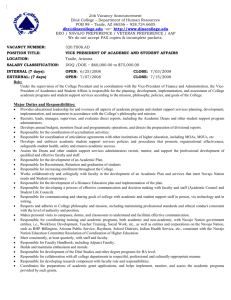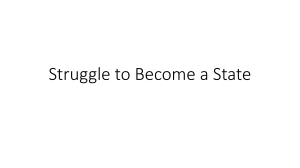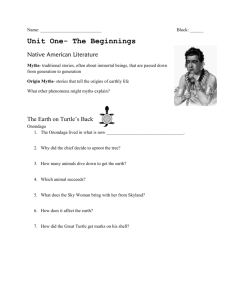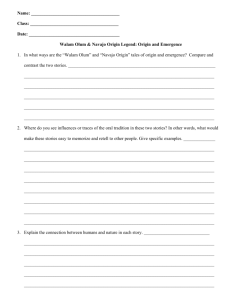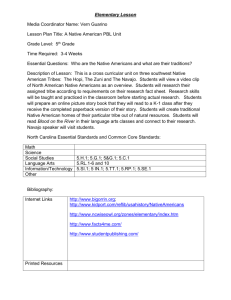Identity & Success In Life (Including Academic Success)
advertisement
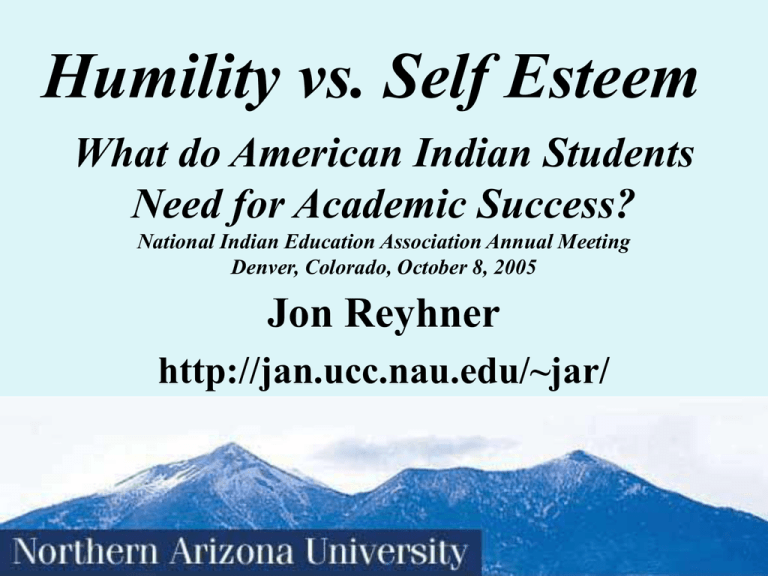
Humility vs. Self Esteem What do American Indian Students Need for Academic Success? National Indian Education Association Annual Meeting Denver, Colorado, October 8, 2005 Jon Reyhner http://jan.ucc.nau.edu/~jar/ Hap Gilliland devotes a whole chapter to self esteem in his book Teaching the Native American and concludes: “Selfesteem is the most important factor in achievement.” However, the Hopi Tribe’s home page notes that their “lifeway…is based on humility, cooperation, respect and earth stewardship.” The National Museum of the American Indian’s Anishanabe exhibit notes the teachings of their Seven Grandfathers include, along with wisdom, love, respect, bravery, honesty and truth, the teaching of dbaadendizin — humility: You are equal to others, but you are not better. Lipka et al. found that Yup’ik teachers rejected the profuse “bubbly” praise promoted by non-Yup’ik teachers because traditional Yup’iks believed “overly praising will ruin a person.” Should Schools Try to Boost Self-Esteem? Beware of the Dark Side •The self-esteem approach…is to skip over the hard work of changing our actions and instead just let us think we’re nicer. •High self-esteem can mean confident and secure—but it can also mean conceited, arrogant, narcissistic, and egotistical. •Self-esteem is mainly an outcome, not a cause. •In practice, high self-esteem usually amounts to a person thinking that he or she is better than other people. If you think you're better than others, why should you listen to them, be considerate, or keep still when you want to do or say something? •Bullies ‘do not suffer from poor self-esteem’…. People with high self-esteem are less willing than other to heed advice, for obvious reasons. •Far, far more Americans of all ages have accurate or inflated views of themselves than underestimate themselves. They don't need boosting. •The modest correlations between self-esteem and school performance do not indicate that high selfesteem leads to good performance. •Efforts to boost the self-esteem of students have not been shown to improve academic performance and may sometimes be counterproductive. •Those with high self-esteem show stronger ingroup favoritism, which may increase prejudice and discrimination. •If anything, high self-esteem fosters experimentation, which may increase early sexual activity or drinking, but in general effects of self-esteem are negligible. •A whopping 25 percent claimed to be in the top 1 percent! Similarly when asked about ability to get along with others, no students at all said they were below average. •There is one psychological trait that schools could help instill and that is likely to pay off much better than self-esteem. That trait is self-control (including self-discipline). •Self-efficacy is also an important concern. Selfefficacy is an earned self-esteemed through the development of competencies. So, if self-esteem is not that important for academic (and life) success, what is? Culture-, Place-, and CommunityBased Education Success in school and in life is related to people’s identity, how as a group and individually people are viewed by others and how they see themselves. Identity is not just a positive self-concept. It is learning your place in the world with both humility and strength. It is, in the words of Vine Deloria (Standing Rock Sioux), “accepting the responsibility to be a contributing member of a society.” It is children as they grow up finding a “home in the landscapes and ecologies they inhabit.” We Are All Related Amy Bergstrom, Linda Cleary and Thomas Peacock in their 2003 study of Indian youth titled The Seventh Generation found that “Identity development from an Indigenous perspective has less to do with striving for individualism and more to do with establishing connections and understanding ourselves in relation to all the things around us.” The Curse of Fry Bread or Powdered Eggs and Spam Students who are not embedded in their traditional values are only too likely in modern America to pick up a culture of consumerism, consumption, competition, comparison, and conformity. Kyril Calsoyas for his 1992 doctoral dissertation The Soul of Education: A Navajo Perspective interviewed Navajo Elder & Medicine Man Thomas Walker who stated, “For over one hundred years the white man has defined what education will be for the Navajo people…. I was brought up with the old philosophy and what I see now with the White Men’s way in today’s world there is a wide difference and the intent of education does not relate any more. Because of this, in this present time, the children that are taught whatever is real, the old philosophy does not touch. The old language does not touch on these things. The children are given too much power. “Whenever you try to correct a child from wrongdoings it becomes difficult to discipline them because of the laws that have been developed to protect children from abuse. When one is trying to discipline a child they say that they are being called names and are being abused. When you try to tell them something and you touch them, the report they were hit. Because of this law that protects them many are wandering and doing whatever they feel like. Because of this others act as if they are the authorities on everything. Because of this, the school administrators are getting in trouble to the point that they lose their jobs. I do not agree with this.” Diné Medicine woman Eva Price stated “there were a lot of teachings back then [in the old days]. There were no bitter words. There were whips and plenty of discipline. Elders didn’t have to demand things twice and they were for your own good. Grandparents have a responsibility to their grandchildren. The relationship is nothing but compassion…. Discipline is always there, is never absent. That is the way I was taught. A Navajo elder told Dr. Parsons Yazzie, “You are asking questions about the reasons that we are moving out of our language, I know the reason. The television is robbing our children of language. It is not only at school that there are teachings, teachings are around us and from us there are also teachings. Our children should not sit around the television. Those who are mothers and fathers should have held their children close to themselves and taught them well, then our grandchildren would have picked up our language.” Dr. Parsons Yazzie found in her doctoral research that, “Elder Navajos want to pass on their knowledge and wisdom to the younger generation. Originally, this was the older people's responsibility. Today the younger generation does not know the language and is unable to accept the words of wisdom.” She continues, “The use of the native tongue is like therapy, specific native words express love and caring. Knowing the language presents one with a strong self-identity, a culture with which to identify, and a sense of wellness.” Donna Deyhle from 20 years of research found that Navajo and Ute students with a strong sense of cultural identity could overcome the structural inequalities in American society and the discrimination they faced as American Indians. In a study of students on three reservations in the upper mid-west, Whitbeck, Hoyt, Stubben and LaFromboise reported in the Journal of American Indian Education in 2001 that the traditional cultural values defined “a good way of life” typified by pro-social attitudes and expectations and that learning the Native culture is a resiliency factor. Deborah House concluded from her study of efforts of Navajo language and cultural revitalization that it has been carried out through a process of devaluing the English language and culture in an oppositional process that has resulted in an emphasis on “image over substance” with little actual progress in keeping Navajo language alive. She concludes that the “current tribal and educational discourse, which advances a Navajo/Western opposition, offers extreme choices, neither of them completely viable, neither of them realistic. Language and culture programs that deal in such essentialist and inadequate currency can only contribute to continued social disease and disorder, and therefore to greater and faster Navajo language shift.” James Banks’ Stages that an Ethnic Minority Individual or Group Can Experience as They Adjust to Living Alongside an Ethnocentric Dominant Ethnic Group Dr. Lori Arviso Alvord, the first Navajo woman surgeon and now an Associate Dean at Dartmouth Medical School, is an example of academic success for Indian students. In her 1999 autobiography The Scalpel and the Silver Bear she writes, “In their childhoods both my father and my grandmother had been punished for speaking Navajo in school. Navajos were told by white educators that, in order to be successful, they would have to forget their language and culture and adopt American ways.” They were warned that if they taught their children to speak Navajo, the children would have a harder time learning in school, and would therefore be at a disadvantage. A racist attitude existed. Navajo children were told that their culture and lifeways were inferior, and they were made to feel they could never be as good as white people.… My father suffered terribly from these events and conditions. He had been a straight-A student and was sent away to one of the best prep schools in the state.” “He wanted to be like the rich white children who surround him there, but the differences were too apparent.” Dr. Arviso Alvord concludes that “two or three generations of our tribe had been taught to feel shame about our culture, and parents had often not taught their children traditional Navajo beliefs–the very thing that would have shown them how to live, the very thing that could keep them strong.” Healing “The Elders tell us that it is alright to feel angry about stuff like this [e.g., the Sand Creek massacre] and it is good. However, in the end you must go down to the river, offer a gift of tobacco to the Creator and simply let the anger go .... Otherwise the anger will poison your spirit…” What Are Some Correlates of Academic Success? •Entering school with a large vocabulary. •Having lots of reading material in the home. •Living close to a library. •Spending more time on homework •Watching less television •Longer school years •Higher incomes •Family and community encouragement Asians tend to see academic success as a product of effort and hard work while Americans tend to see academic success as a matter of the intelligence (IQ) that you are born with. Maybe that is the reason why Asian-Americans on average do better academically in the United States than other groups, including “white” Americans. Alfie Kohn in his1993 book Punished by Rewards looked at the research on student motivation and concluded that external or extrinsic rewards, including praise, grades and tokens (like smelly stickers and candy for younger students or even money for good grades for older students), can have negative effects on students' academic performance. He concludes: don't praise people, only what people do make praise as specific as possible avoid phony praise avoid praise that sets up competition Instead of external rewards to motivate students, Kohn recommends educators should give students interesting material to learn, a learning community environment, and choice. When students find what they are studying is interesting and enjoyable they are being intrinsically rewarded for their learning. Some Thoughts on Grading Richard L. Allington Achievement-based grading – where the best performances get the best grades – operates to foster classrooms where no one works very hard. The higher-achieving students don’t have to put forth much effort to rank well and the lowerachieving students soon realize that even working hard doesn't produce performances that compare well to those of higher-achieving students. Hard work gets you a C, if you are a lucky lowachiever, in an achievement-based grading scheme. Exemplary teachers evaluated student work based more on effort and improvement than simply on achievement status. This focus meant that all students had a chance at earning good grades, regardless of their achievement levels. This creates an instructional environment quite different from one where grades are awarded based primarily on achievement status. In those cases, the highachieving students do not typically have to work very hard to earn good grades. Lower-achieving students often have no real chance to earn a good grade regardless of their effort or improvement. Judging School Performance 2005 PDK/Gallup Poll Americans believe that school performance should be judged by the improvements students show and not by the percentage of students passing the state-selected test. Foundations of Resilience Iris Heavy Runner • Sense of Purpose • Spiritual Connectedness • Optimism • Goals • Autonomy • Sense of Identity • Self-Awareness • Adaptive Distancing • Task Mastery • Social Competence • Cultural Flexibility • Sense of Humor • Caring • Problem-Solving • Planning • Critical Thinking • Help Seeking On March 8-10, 2004, the Bureau of Indian Affair’s Office of Indian Education Programs (OIEP) held its third Language and Culture Preservation Conference in Albuquerque, New Mexico. OIEP director Ed Parisian welcomed the large gathering of Bureau educators to this meeting, emphasizing the BIA’s goal that “students will demonstrate knowledge of language and culture to improve academic achievement.” He went on to say that “we know from research and experience that individuals who are strongly rooted in their past—who know where they come from—are often best equipped to face the future.” Cultural Guiding Threads Ka Moÿopuna I Ke Alo College of Hawaiian Language, UHHilo Building a legacy for the children of today, and the generations of tomorrow HONUA (Sense of Place): Developing a strong sense of place, and appreciation of the environment and the world at large, and the delicate balance to maintain it for generations to come. HÖÿIKE (Sense of Discovery): Measuring success and outcomes of our learning through multiple pathways and formats. KUANA'IKE (Perspective/Cultural lens): Increasing global understanding by broadening the views and vantage points from which to see and operate in the world. (Developing the cultural lens from which to view and operate in the world) MAULI (Cultural Identity): Strengthening and sustaining Native Hawaiian cultural identity by incorporating practices that support the learning, understanding, behaviorsw/actions, and spiritual connections through the use of the Hawaiian language, culture, history, heritage, traditions and values. NA'AUAO (Wisdom): Instilling and fostering a lifelong desire to seek knowledge and wisdom, and strengthening the thirst for inquiry and knowing. PIKO (Sense of Connection): Enriching our bonds with the people, places and things that influence our lives through experiences that ground us to our spirituality and connect us to our genealogy, culture, and history through time and place. PIKOÿU (Sense of Self): Promoting personal growth and development, and a love of self, which is internalized and develops into a sense of purpose/role. (Growing aloha and internalizing kuleana to give back) Navajo Education East Thinking Spiritual–Praying/Singing Reverence/Sacrifice Curiosity South Active/Laziness North Planning Memory/Forgetfulness Sense of Protection Personality–Dress/Behavior Common Sense/Stupidity Physical Hygiene/Exercise Self Actualization Patience Positive Self-Concept/Boastful Cleanliness/Lice Care/Jealousy–Envy Proper Diet/Hunger-Thirst Mindful/Stubborn Health/Sickness-Rapidly Aging West Life Social – Clans/Kinship terms Respect/Communication Good Stories/Gossip Generosity/Greed As presented by Ernest Harry Begay for WRUSD No.8 Conserve/Poverty Iñupiaq Elders met and came up with a list of their values: • knowledge of language • sharing • respect for others • cooperation • respect for elders • love for children • hard work • knowledge of family tree • avoidance of conflict • • • • • • • • respect for nature spirituality humor family roles hunter success domestic skills humility responsibility to tribe Figure 4. Chil dhood poverty rates in rich countries. (Reprinted from UNICEF, 2005, used by permi ssion.) Figure 5. Percent of the poor li ving at half the official poverty rate. (Reprinted from Mishel, Bernstein and All egretto, 2005. Used by permi ssion of the publi sher, Cornell University Press.) Ganado Mission School’s Entrance About 1950 Effects of Assimilation The National Research Council (1998) found that immigrant youth tend to be healthier than their counterparts from nonimmigrant families. It found that the longer immigrant youth are in the U.S., the poorer their overall physical and psychological health. Furthermore, the more Americanized they became the more likely they were to engage in risky behaviors such as substance abuse, unprotected sex, and delinquency. References Allington, Richard D. 2002, June. What I've Learned About Effective Reading Instruction From a Decade of Studying Exemplary Elementary Classroom Teachers. Phi Delta Kappan, 740-747. Banks, James. 1992. The Stages of Ethnic Identity. In P.A. Richard-Amato & M. A. Snow (eds.), The Multicultural Classroom. Reading, MA: Addison Wesley Baumeister, R.F., Campbell, J.D., Krueger, J.I., & Vohs, K.D. 2003. Does High Self-Esteem Cause Better Performance, Interpersonal Success, Happiness, or Healthier Lifestyles. Psychological Science in the Public Interest 4:1-44. Baumeister, R.F., Smart, L., & Boden, J.M. 1996. Relation of Threatened Egotism to Violence and Aggression: The Dark Side of High Self-Esteem. Psychological Review 103:3-33. Calsoyas, Kyril. 1992. The Soul of Education: A Navajo Perspective. Unpublished doctoral dissertation, Northern Arizona University, Flagstaff, AZ. Cleary, Linda Miller, & Peacock, Thomas D. (998. Collected Wisdom: American Indian Education. Boston, MA: Allyn & Bacon. Deloria, Jr., V., & Wildcat, D.R. 2001. Power and Place: Indian Education in America. Golden, CO: Fulcrum Resources. Deyhle, Donna. 1992. Constructing Failure and Maintaining Cultural Identity: Navajo and Ute School Leavers. Journal of American Indian Education 31(2):24-47. Gilliland, Hap. 1999. Teaching the Native American (4th Ed.). Dubuque, IO: Kendall/Hunt. House, D. 2002. Language Shift among the Navajos. Tucson: University of Arizona. Kohn, Alfie. 1993. Punished by Rewards. New York: Houghton Mifflin. Lipka, Jerry, Mohatt, Gerald, & the Ciulistet Group. 1998. Transforming the Culture of Schools: Yup'ik Eskimo Examples. Mahwah, NJ: Lawrence Erlbaum. Parsons Yazzie, Evangeline. 1995. A Study of Reasons for Navajo language Attrition as Perceived by Navajo Speaking Parents. Unpublished doctoral dissertation, Northern Arizona University, Flagstaff, AZ. Reyhner, Jon. 2006. Education and Language Restoration. Contemporary Native American Issues Series. Philadelphia, PA: Chelsea House. Reyhner, Jon, & Eder, Jeanne. 2004. American Indian Education: A History. Norman, OK: University of Oklahoma Press. Reyhner, Jon. (ed.). 1992. Teaching American Indian Students. Norman, OK: University of Oklahoma Press. Whitbeck, L.B., Hoyt, D.R., Stubben, D.R., LaFromboise, T. 2001. Traditional Culture and Academic Success Among American Indian Children in the upper Midwest. Journal of American Indian Education 40(2):48-60.


